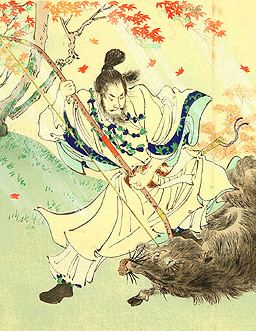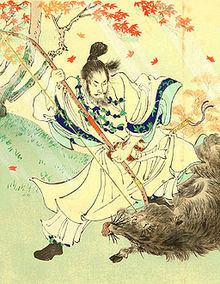Predecessor Anko Name Emperor Yuryaku | ||
 | ||
Reign 456 – 479 (traditional) Died 479 (aged 71)Hatsuse no asakura Palace Burial Tajii no Takawashi-hara no misasagi (Osaka) | ||
Emperor Yūryaku (雄略天皇, Yūryaku-tennō) was the 21st emperor of Japan, according to the traditional order of succession.
Contents

Yūryaku is remembered as a patron of sericulture.
No firm dates can be assigned to this emperor's life or reign, but he is conventionally considered to have reigned from 456 to 479.
Legendary narrative
Yūryaku was a 5th-century monarch. The reign of Emperor Kinmei (c. 509 – 571 AD), the 29th emperor, is the first for which contemporary historiography is able to assign verifiable dates; however, the conventionally accepted names and dates of the early emperors were not to be confirmed as "traditional" until the reign of Emperor Kanmu (737–806), the 50th sovereign of the Yamato dynasty.
According to the Kojiki, this emperor is said to have ruled from the Thirteenth Day of the Eleventh Month of 456 (Heishin) until his death on the Seventh Day of the Eight Month of 479 (Kibi).
According to Kojiki and Nihonshoki, Yūryaku was named Prince Ōhatsuse Wakatake (大泊瀬 幼武) at birth. Swords unearthed from some kofun tombs, such as the Inariyama Sword pictured at right, indicate his name was Waka Takeru (Ōkimi). Yūryaku is a name posthumously assigned to him by a much later era. He was the fifth and youngest son of Emperor Ingyō. After his elder brother Emperor Ankō was murdered, he won the struggle against his other brothers and became the new emperor. His title at his own lifetime was certainly not tennō, but presumably Ōkimi and/or Sumeramikoto (治天下大王 - amenoshita shiroshimesu ōkimi, or sumera no mikoto, Great King who rules all under heaven) and/or king of Yamato (ヤマト大王/大君 - yamato ōkimi, Great King of Yamato). He had three wives (including his consort Kusahahatahi). His successor, Prince Shiraka (Emperor Seinei), was his son by his wife Kazuraki no Karahime.
In 463, Yūryaku Tennō invited the thunder god of the Mimuro hill to come to the Imperial Palace, and ordered Chiisakobe no muraji Sugaru to fetch the deity. He obliged, thinking the supernatural being would have no reason to refuse the invitation, and rode carrying a halberd with a red banner, symbolising his office of royal messenger. Soon enough, the thunder stroke, and Sugaru enlisted the help of priests to enshrine the kami into a portable carriage, to be brought in the Emperor's presence, as a great serpent. But, said Emperor neglected to practice proper ritual purification and religious abstinence. The thunder kami then showed his displeasure through thundering and threatening fiery eyeballs, and Emperor Yūryaku fled into the interior of the Palace while covering his eyes. The great serpent was returned to Mimuro, and the Emperor made many offerings to appease the angry deity. This story is recorded in Nihongi and mentioned by William George Aston, in "Shinto, the Ancient Religion of Japan" as well as several other books.
The actual site of Yūryaku's grave is not known. This emperor is traditionally venerated at a memorial Shinto shrine (misasagi) at Osaka.
The Imperial Household Agency designates this location as Yūryaku's mausoleum. It is formally named Tajii no Takawashi-hara no misasagi.
Consorts and children
Empress: Kusaka no hatabihime no Himemiko (草香幡梭姫皇女), daughter of Emperor Nintoku Or Emperor Richū
Lady: Katsuragi no Karahime (葛城韓媛), daughter of Katsuragi no Tsubura no Ōomi (葛城円大臣)
Lady: Kibi no Wakahime (吉備稚媛) (?–479), daughter of Kibi no Kamitsumichi no omi (吉備上道臣)
Lady: Wani no ominagimi (和珥童女君), daughter of Kasuga no Wani no omi Fukame (春日和珥臣深目)
King Bu
King Bu, supposed to be Yūryaku Minabo Tarriko, sent an envoy to the emperor of Liu Song, a minor Chinese dynasty, in 478. The ambassador explained that their ancestors were the conquerors of 115 barbarian countries. This claim was followed by the request of military support against Goguryeo of the Three Kingdoms of Korea.
Yūryaku is believed to be referred to as Bu in contemporary Chinese records (武; read as Take or Takeru in Japanese). These records state that Bu began his rule before 477, was recognized as the ruler of Japan by the Liu Song, Southern Qi, and Liang dynasties, and continued his rule through to 502. Bu sent messengers to the Song dynasty in 477 and 478 to ask for military support for protecting Baekje against the threat of Goguryeo.
Poetry
This Japanese sovereign's interest in poetry is amongst the more well-documented aspects of his character and reign. Poems attributed to this 5th-century monarch are included in the Man'yōshū, and a number of his verses are preserved in the Kojiki and the Nihonshoki.
